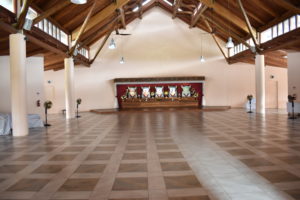Universal Meditation Centre
Universal Meditation Centre
A 1000 Petal Lotus
Universal Meditation Centre
Every individual comprises four dimensions-physical, intellectual, mental and spiritual. Education in schools generally focuses on the first two, but rarely on the other two aspects. Swamiji says, “What is education? Is it book-learning? No. Is it diverse knowledge? Not even that. The training by which the current and expression of will are brought under control and become fruitful is called education.”Meditation is a fundamental tool for developing control of mind and harnessing the higher creative energies potential in each and every individual. The purpose of meditation is to train the mind to focus on a point of stillness within, beyond any distraction caused by the outside world and the mind itself.
It is well known that regular practice strengthens concentration and increases one’s ability to cope with stress and anxiety, develop mastery over the emotions, actions and reactions. Learning the practice of meditation at an early age is important in providing a solid foundation for every individual, regardless of their cultural tradition, and greatly assists students in their studies as well as in their later life, whatever they choose to do. Furthermore, the highly competitive and materialistic world places everyone under great pressure and strain. Meditation offers the inner platform for harmonizing and focusing the energies, regaining poise and inner peace.
- In order to bring out this human excellence in the youth of Fiji, the Centre built the Universal Meditation Centre in 2014.


Steps to Guided Meditation
(For the Meditation of Students of Swami Vivekananda College at its Universal Meditation Centre)
- Sit in a steady and comfortable posture keeping the head, neck and chest upright. Close your eyes.
- Withdraw your mind from the outside world.
- Think of your true nature – the Divinity within you.
- Breathe in a rhythmic way : Think like this :
- Breathe in Purity, breathe out impurity
- Breathe in Power, breathe out weakness
- Breathe in Perfection , breathe out imperfection
- Pray for all.
- Choose your object of Meditation. In the position of the heart, visualise a light – bright and still. Think it to be the symbol of the Divinity in you.
- Concentrate your entire mind in looking at that Light within you.
- Meditate on it for 10 minutes.
- Offer the results of your today’s Meditation to the Divinity in you.
- Please end your Meditation now and open your eyes.
The Concept and Design
The plan and form of the Meditation Hall has been designed with a number of unique features which make it specific for its use and also specific to this particular location and site. These features include:
- Alignment of the Meditation Hall: The alignment of the hall is not arbitrary, it is aligned so that the sunrise on 18th February, the anniversary of Sri Ramakrishna’s birthday, will enter the glazed central slot in the lower part of the eastern façade and shine directly along the central axis onto his image on the centre of the platform. This slot is so designed to exclude the sun’s rays at other times, the only exception being the corresponding date on the sun’s southern path around 22nd October. This is a device often used in ancient times where structures where aligned to admit the sunrise on a particular day and illumine or worship a sacred image or symbol.
The representation of a Upanishadic meditation technique: The form of the building is in the shape of the bow and arrow emphasizing a traditional teaching of meditation, aiming at and then connecting with that target which is beyond this manifest world, and towards which all traditions focus – the point of stillness within each of us – the point where the truth and knowledge of our own inner selves becomes evident. The curved ‘bow’ form is the enclosing rendered masonry wall at the western end, gathering in from beyond the building’s broad roof, embracing those images and symbols representing the great spiritual teachers and traditions. - From many to One: The angled side walls all radiate from the centre of the ‘bow’, allowing entry to the main space from many different directions, – from whichever tradition one approaches.
- At the centre of this curved wall, on a raised platform are photoframes Sri Ramakrishna, flanked by Sri Sarada Devi, Swami Vivekananda, Christ and a representation of Islamic faith.
- Above this platform in the centre of the curved wall is be a large ‘Om’ symbol in Sanskrit in simple relief in the rendered surface, symbolizing the unmanifest Truth at the core of all traditions. A truth which can only be found by looking within, not without, although once found and known by direct experience, it is evident everywhere. Thus Sri Ramakrishna and all the other great teachers represented on the altar look towards the spiritual seekers and to the world beyond the enclosure of the space. This metaphor is reinforced by the sun’s rays directed towards the embodiment of Truth in the form of Sri Ramakrishna, on the anniversary of his birth.
- The Meditative mind and illumination: When entering the hall, the outside world will be screened from view by the overlapping of the angled walls, emphasizing the internal focus of meditation, beyond the distraction of the everyday world. But when the student has learnt to meditate, and found that still point within, he/she turns around and the world outside is instantly visible between these radiating walls, but now with the still point as centre or focus of this view.
At present, meditation sessions are conducted by a Swami for all students of Swami Vivekananda College accompanied by their teachers. The practice is bringing a very positive impact on the students.